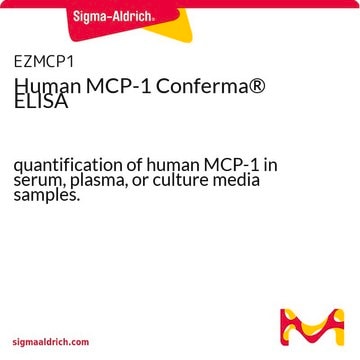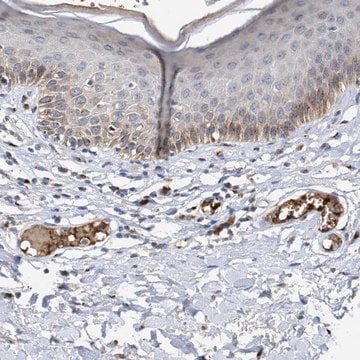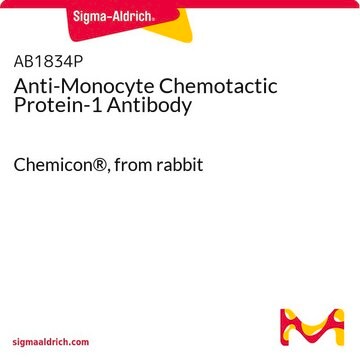MABN712
Anti-CCL2 Antibody, clone 2D8
clone 2D8, from mouse
Sinônimo(s):
C-C motif chemokine 2, Monocyte chemoattractant protein 1, Monocyte chemotactic and activating factor, Monocyte chemotactic protein 1, Monocyte secretory protein JE, Small-inducible cytokine A2
About This Item
Produtos recomendados
fonte biológica
mouse
Nível de qualidade
forma do anticorpo
purified antibody
tipo de produto de anticorpo
primary antibodies
clone
2D8, monoclonal
reatividade de espécies
monkey, mouse, rat, human
técnica(s)
flow cytometry: suitable
immunofluorescence: suitable
immunohistochemistry: suitable
western blot: suitable
Isotipo
IgG1
nº de adesão UniProt
Condições de expedição
wet ice
modificação pós-traducional do alvo
unmodified
Informações sobre genes
human ... CCL2(6347)
Descrição geral
Imunogênio
Aplicação
Immunohistochemistry Analysis: A 1:200-1,000 dilution from a representative lot detected CCL2 in human liver cancer tissue.
Flow Cytometry Analysis: A 1:200-400 dilution from a representative lot detected CCL2 in A549 cells.
Optimal working dilutions must be determined by end user.
Neuroscience
Signaling Neuroscience
Qualidade
Western Blotting Analysis: A 1:500-2,000 dilution of this antibody detected CCL2 in A549, HeLa, Raw264.7, L1210, C6 and COS-7 cell lysates
Descrição-alvo
forma física
Armazenamento e estabilidade
Nota de análise
A549, HeLa, Raw264.7, L1210, C6 and COS-7 cell lysates
Exoneração de responsabilidade
Not finding the right product?
Try our Ferramenta de seleção de produtos.
Código de classe de armazenamento
12 - Non Combustible Liquids
Classe de risco de água (WGK)
WGK 2
Ponto de fulgor (°F)
Not applicable
Ponto de fulgor (°C)
Not applicable
Certificados de análise (COA)
Busque Certificados de análise (COA) digitando o Número do Lote do produto. Os números de lote e remessa podem ser encontrados no rótulo de um produto após a palavra “Lot” ou “Batch”.
Já possui este produto?
Encontre a documentação dos produtos que você adquiriu recentemente na biblioteca de documentos.
Nossa equipe de cientistas tem experiência em todas as áreas de pesquisa, incluindo Life Sciences, ciência de materiais, síntese química, cromatografia, química analítica e muitas outras.
Entre em contato com a assistência técnica






